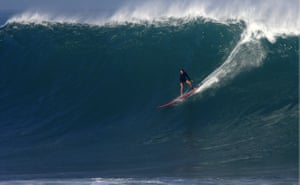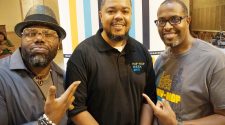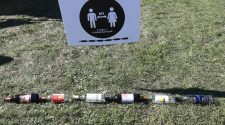It looks like the sea is aiming at her.
The wave lifts, lunges and detonates and Mercedes Maidana lies on her board as she is engulfed and vanishes, sucked into a booming, churning cloud.
She is rescued and returns to shore on a jet ski, life vest bulging under her wetsuit. A red rivulet drips down her face from a cut above her left eye but she gives a thumbs up and smiles for the camera, blinking the salty spray and the blood out of her eyes.
It seems like a lucky escape.
“I saw her a couple of minutes ago, she’s real happy,” a commentator reports during a television highlights show. “She has a little tiny scar up there, they didn’t have to put stitches in, she got some glue and she’s back out here enjoying the fun.”
Maidana started vomiting that night. She was diagnosed with a mild concussion after a scan at an emergency room and told to rest. She returned home to Hawaii with a black eye. A few days later her mind and her body began to fail.
At the time of the competition in March 2014 at Nelscott Reef, a two-hour drive from Portland, Maidana was one of the best big-wave surfers in the world. Since taking up the sport in her early twenties she had worked tirelessly, obsessively, spending hours each day developing her skills in the wild waves on Maui’s famous North Shore and hours on land building up her fitness.
Yet within weeks of her board smashing into her forehead she could barely get off the couch or hold a conversation. Her tongue was leaden. She was too weary to walk her dog. Even sending a text message was exhausting. She was dizzy, confused, anxious, depressed and paranoid. Three months after the accident she got divorced.
“My world just crumbled. I lost my husband, my dog, my house, my sponsorship, I had a coaching business, I couldn’t do it any more. I lost everything,” she recalls. “The cut, the cut in your eyebrow! We were all concerned about the blood, instead of what’s happening underneath.”
While concussions in major contact sports, notably American football, attract most of the research and media attention, traumatic head injuries in surfing are the shadow amid the sunshine – rarely discussed and poorly understood despite their potentially devastating effects.
Studies suggest a significant minority of surfers suffer head injuries that carry a risk of cognitive decline in addition to the immediate danger of drowning.
An analysis of surfing-related concussions on the west coast of Canada by Nikolaus Dean at the University of British Columbia in 2018 found that the sport’s culture “encouraged risk-taking behaviors and the denial and downplaying of the injury”. There is a reluctance to wear protective headgear, limited medical help and established protocols compared to major team sports and peer pressure to return to the waves without adequate recovery time.
“The lifestyle is all happy, we’re at the beach, and the sponsors show that image,” Maidana says. “Nobody talks about concussions in surfing and nobody ever wants to talk about mental illness.”
Another elite big-wave surfer, Shawn Dollar, set a world record in 2012 by paddling into a 61ft wave. He also competed at Nelscott Reef in 2014. The following year he smashed into a boulder while surfing in a remote location off the central Californian coast, breaking his neck in four places and suffering a concussion. He had to walk with assistance for a mile to reach his car and be driven to hospital.
Bones healed but his brain is still a work in progress. “It looked like I’d played the equivalent of high school, college and professional football,” he says. “I’ve had a full recovery but I still am improving, honestly, I still have to take care of myself every day. I’m doing really, really well but it’s taken, like, three years and a lot of work.”
He felt less mentally sharp after the blow. “I was kind of paying attention to what was going on in the news with the NFL and stuff like that but I was a little bit in denial about it, it just seemed crazy that I could be experiencing those type of things just from surfing. And there wasn’t any data out there but I was noticing that I was getting more foggy-headed and slower over time, it was affecting my well-being,” he says.
Maidana returned to the water but eventually realized that she was “causing concussions over my concussions. Like a boxer’s brain, basically.” In dire need of money, with her medical care not covered by insurance, she tried delivering pizza and cleaning houses but was too unwell.
To force herself away from the ocean she moved to Austin, Texas, and took a job in a cafe. “A doctor told me when I got to Austin, ‘you are an inch from a stroke’, if I kept surfing,” she says. “I removed myself from the island to heal to save my life.”

At one point, when she did not maintain a strict healthy diet, she had suicidal thoughts. “It was like – just end it, just end it, just end it. A lot of it was the nostalgia of what I lost. ‘Life without big-wave surfing is nothing, look what your life was before, living at the beach, you were in Hawaii, now you’re in Austin, you’re a waitress, life sucks’, basically. And it was so scary.”
Now doing better and spending time with family in her native Argentina, in hindsight, Maidana is sure that her injury in Oregon had its roots in hidden trauma from an accident in Maui the week before. “I got two 50ft waves right on the head in the impact zone [where the wave is most powerful],” she says.
“It was like a horror movie, so much time underwater, it was just so violent what was happening, the beating in my body and the lack of oxygen. I truly was one inch from dying. I really felt: OK, the next moment I’m going to be on the other side. It was OK, I was peaceful about it. In a way I wanted it to end because I was feeling really bad, I just wanted the peacefulness.”
But she did not seek treatment: “I didn’t get hit, I’m breathing, that’s all I need,” she thought. Then the waves in Nelscott were higher than she expected.
“That’s when the terror started to creep in, I was very nervous, very uncomfortable in the water. A 35ft wave, nowhere to go, that’s the moment where you have to ditch your board and dive as much as you can, go under the wave. I freaked out, that’s when I think the PTSD came, I froze, I saw the wave and I just didn’t do anything and it just took me,“ she says.
“It hits me underwater with the lip of the wave – imagine a 35ft wave bringing a 10ft board that’s like a table, into my forehead. I got hit, I felt a quick in-and-out, black stars, pulled my inflatable vest. When I went black, I was like, come back – because if you don’t come back right now, you go.”
Daniel Amen, a doctor in California who has treated numerous surfers, including Maidana and Dollar, often finds they have frontal lobe brain injuries which affect judgment and impulse control.
“The surfer of a 30ft wave has to be incredibly coordinated and make split-second decisions; well, now they’re not quite so good and it means they’re more likely to get another concussion because in their heads they’re going ‘I can do this’ but their processor isn’t reacting as it should,” he says.
Maidana hopes her experience will raise awareness of the perils of big-wave surfing. Dollar suspects a culture shift will be hard to achieve. “I don’t think helmets are going to make a difference, I think it’s about surfers being aware that when they take off on a giant close-out wave just for, like, a photo, they could suffer brain damage from that wipeout,” he says.
“When I talk to the younger guys they’re aware of what I went through and they’re asking questions like how can they prevent it themselves, how can they take care of themselves, what have they got to do. At the end of the day they’re still all charging really hard and getting hurt constantly. There’s an awareness out there but there isn’t really a change.”














